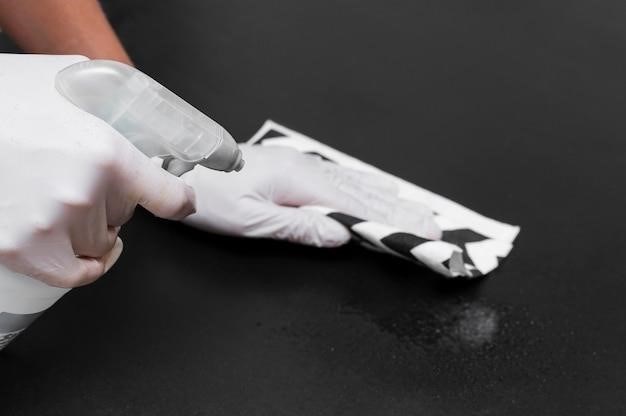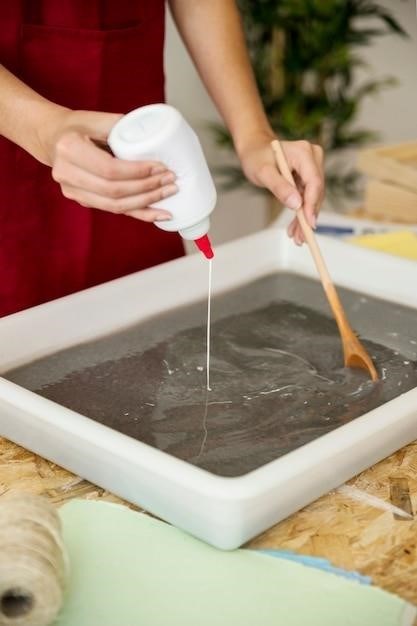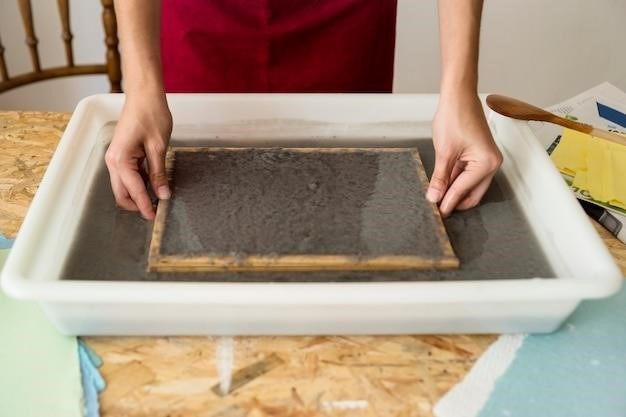Epodex Instructions⁚ A Comprehensive Guide
This comprehensive guide provides you with all the necessary information to successfully work with Epodex epoxy resin. From preparation and safety to application techniques and troubleshooting, we cover everything you need to know to achieve professional results on your projects.
Introduction
Epodex epoxy resin has become a popular choice for DIY enthusiasts and professionals alike due to its versatility and ease of use. Whether you’re crafting stunning jewelry, creating durable tabletops, or sealing floors, Epodex offers a range of products designed to meet your specific needs. This guide will equip you with the knowledge and skills necessary to confidently work with Epodex epoxy resin, ensuring your projects turn out beautifully and last for years to come.
We’ll delve into the different types of Epodex products available, providing detailed instructions on preparation, mixing, and application techniques. From understanding curing times and troubleshooting common issues to exploring tips for achieving professional results and proper cleaning and maintenance, this comprehensive guide will be your ultimate resource for working with Epodex.
Whether you’re a seasoned crafter or a curious beginner, this guide will empower you to unleash your creativity and achieve exceptional results with Epodex. So, gather your materials, put on your protective gear, and let’s embark on a journey into the world of Epodex epoxy resin.
Types of Epodex Products
Epodex offers a diverse range of epoxy resin products, catering to various project needs and skill levels. Each product is carefully formulated with specific properties, making them ideal for different applications.
For beginners and smaller projects, the Epodex Deep Pour & Casting Kit stands out. This crystal-clear, UV-stabilized resin is self-leveling, making it easy to work with and perfect for crafting jewelry, coasters, and small castings.
For larger projects like river tables, floors, and lamps, Epodex offers their PRO and ECO systems. The PRO system boasts a higher maximum pouring height and produces a clearer finish, making it suitable for deep pours and intricate designs. The ECO system, while having a lower maximum pouring height, cures quickly and is ideal for laminating, thin sealing coats, and colored projects.
Epodex also provides specialized products like their Chalk Paint, which offers a unique finish for upcycling furniture and other objects. Additionally, their Microcement is designed for coating floors, providing a durable and stylish surface.
Understanding the specific properties of each Epodex product will allow you to select the perfect resin for your project, ensuring optimal results and a satisfying experience.
Preparation and Safety
Before embarking on your Epodex project, prioritizing preparation and safety is paramount. This ensures a smooth workflow and a safe environment for you and those around you.
Start by assembling your workspace in a well-ventilated area, free from dust and debris. Protect your work surface with a drop cloth or plastic sheeting to prevent spills and accidental damage.
Safety gear is essential when working with epoxy resin. Wear disposable gloves to protect your hands from contact with the resin and hardener. A respirator mask is also recommended to prevent inhaling fumes, especially in enclosed spaces. Eye protection, such as goggles, should be worn to safeguard your eyes from potential splashes.
When handling the epoxy resin and hardener, be mindful of the mixing ratio. Using the correct proportions is crucial for achieving the desired results and ensuring proper curing. Consult the specific instructions provided with your chosen Epodex product for the accurate mixing ratio.
Always store epoxy resin and hardener in their original containers, tightly sealed, and in a cool, dry place. Keep them away from direct sunlight and heat sources to maintain their quality and prevent premature hardening.
By following these preparation and safety guidelines, you can create a controlled and secure environment for your Epodex project, ensuring a successful and enjoyable experience.
Mixing Instructions
Precise mixing is fundamental to achieving the desired outcome with Epodex epoxy resin. The instructions provided with your specific product will outline the correct mixing ratio, typically a 2⁚1 ratio of resin to hardener. Carefully measure both components using a graduated cylinder or measuring cups.
Pour the measured resin into a clean mixing container, followed by the measured hardener. Use a mixing stick or a spatula to thoroughly combine the two components. The key is to ensure that the resin and hardener are completely blended, leaving no visible streaks or clumps.
For optimal mixing, employ a technique that incorporates both stirring and scraping the sides and bottom of the container. This ensures that all components are thoroughly mixed, leading to a consistent and uniform epoxy mixture.
Avoid incorporating air bubbles into the mixture during the mixing process. Gentle and deliberate stirring minimizes the introduction of air bubbles, which can compromise the clarity and appearance of your final project.
The working time of the epoxy mixture varies depending on the specific product and environmental conditions. Refer to the instructions provided with your Epodex product for guidance on the recommended working time. Within the allotted working time, the epoxy mixture remains fluid and can be applied to your project; After the working time expires, the epoxy begins to cure and solidify.
Application Techniques
Applying Epodex epoxy resin requires a combination of precision and care to achieve the desired results. First, ensure your work surface is clean and free of dust or debris, as these can become embedded in the epoxy and affect its clarity. Use a damp cloth to wipe down the surface before applying the epoxy.
Pour the mixed epoxy resin onto the prepared surface, working in sections if necessary. Spread the epoxy evenly using a squeegee, roller, or brush, depending on the project and desired finish. For larger projects, consider using a pour pot with a spout to control the flow of epoxy.
When working with multiple layers of epoxy, allow each layer to cure according to the manufacturer’s instructions before applying the next. This ensures proper adhesion and prevents the layers from separating. Pay attention to the recommended layer thickness for your specific Epodex product, as this will vary depending on the type of epoxy and the project.
To achieve a smooth and bubble-free finish, gently tap or heat the epoxy surface during curing. This helps to release any trapped air bubbles and promotes a more polished look.
After application, allow the epoxy to cure completely according to the manufacturer’s instructions. The curing time may vary depending on factors such as temperature and humidity. Avoid disturbing the epoxy during the curing process to ensure optimal results.
Curing Time and Process
The curing time for Epodex epoxy resin is a critical factor in achieving the desired finish and strength. The curing process involves a chemical reaction between the resin and hardener, transforming the liquid mixture into a solid, durable material.
Epodex epoxy resin typically cures within 24-72 hours, depending on the specific product and environmental conditions. Higher temperatures can accelerate the curing process, while colder temperatures may slow it down. Humidity can also affect curing time, with higher humidity potentially extending the curing period.
During the curing process, the epoxy resin goes through several stages, including⁚
Initial Set⁚ This stage typically occurs within a few hours after mixing, where the epoxy begins to thicken and lose its fluidity.
Tacky Stage⁚ After the initial set, the epoxy becomes tacky and can be handled with care. This stage can last for several hours.
Hard Cure⁚ The epoxy reaches its full hardness and strength during the hard cure stage, which can take up to 72 hours.
While the epoxy may appear cured after a few hours, it’s essential to allow the full curing time to ensure optimal strength, durability, and resistance to yellowing. Avoid applying any pressure or stress to the epoxy during the curing process to prevent warping or cracking.
Troubleshooting Common Issues

While working with Epodex epoxy resin, you may encounter some common issues. Understanding the causes and solutions for these problems can help you achieve a successful outcome for your project.
Air Bubbles⁚ Air bubbles can appear in the epoxy during mixing or pouring. To minimize bubbles, mix the resin and hardener slowly and carefully. You can also use a heat gun or torch to gently warm the epoxy, which can help release trapped air. Additionally, consider pouring the epoxy in a thin layer, as this can reduce the formation of bubbles.
Yellowing⁚ Exposure to UV light can cause epoxy resin to yellow over time. To prevent yellowing, use UV-stabilized epoxy resin, which is designed to resist discoloration. You can also apply a protective coating or varnish to your finished project.
Uneven Surface⁚ An uneven surface can result from improper mixing, pouring, or leveling. Ensure you mix the resin and hardener thoroughly and pour the epoxy evenly. Use a leveling tool or scraper to smooth out the surface and remove any air bubbles.
Cracking⁚ Cracking can occur due to rapid curing, excessive heat, or stress on the epoxy. To prevent cracking, cure the epoxy slowly and avoid applying too much pressure during the curing process. Consider using a flexible mold or substrate to allow for expansion and contraction.
Poor Adhesion⁚ If the epoxy doesn’t adhere well to the surface, it could be due to poor preparation or incompatible materials. Clean the surface thoroughly before applying epoxy, and ensure that the substrate is compatible with epoxy resin.
Tips for Achieving Professional Results
Epodex epoxy resin offers the potential for stunning and durable finishes, but achieving professional results requires attention to detail and a few key techniques. Here are some tips to help you elevate your epoxy projects⁚
Prepare Your Work Area⁚ A clean and organized workspace is essential for successful epoxy work. Clear away any dust or debris that could contaminate the resin. Consider using a dust mask and gloves to protect yourself from potential irritants.
Use Quality Materials⁚ Epodex offers a range of products designed for specific applications. Choose the right resin and hardener for your project, and always use high-quality tools and equipment.
Measure Carefully⁚ Precise measurements are crucial when working with epoxy resin. Use a measuring cup or scale to ensure the correct ratio of resin to hardener for optimal performance and curing.
Mix Thoroughly⁚ Proper mixing is essential to ensure the resin and hardener blend evenly. Use a mixing stick or drill with a mixing attachment to thoroughly combine the components until the mixture is completely uniform.
Pour Slowly and Evenly⁚ Avoid rushing the pouring process. Pour the epoxy slowly and evenly to prevent air bubbles and create a smooth, consistent surface. Use a leveling tool or scraper to smooth out any imperfections.
Cure Properly⁚ Follow the manufacturer’s instructions for curing time and temperature. Allow the epoxy to cure completely before handling or applying any additional coatings or finishes.
Sand and Finish⁚ Once the epoxy has cured, you can sand and finish the surface for a professional look. Use progressively finer grit sandpaper to achieve a smooth and even finish. Consider using a polishing compound for a high-gloss sheen.
Experiment and Learn⁚ Epoxy resin offers a wide range of possibilities. Experiment with different techniques, colors, and embellishments to discover your own creative style.
Cleaning and Maintenance
Maintaining the pristine look of your Epodex epoxy creations involves a few simple steps to ensure their longevity and beauty. Here’s a guide to keeping your epoxy projects clean and in top condition⁚
Clean Up Spills Promptly⁚ Epoxy resin is a sticky substance that can be challenging to remove once it hardens. Clean up any spills immediately with a damp cloth or paper towel. For stubborn stains, use a mild soap solution or a specialized epoxy cleaner.
Avoid Harsh Chemicals⁚ Harsh chemicals, such as bleach or strong solvents, can damage the epoxy surface. Use a mild cleaning solution or a specialized epoxy cleaner specifically designed for cleaning epoxy surfaces.
Protect From UV Exposure⁚ Prolonged exposure to ultraviolet (UV) rays from sunlight can cause epoxy resin to yellow over time. Protect your epoxy projects from direct sunlight by storing them indoors or using a UV-resistant sealant.
Regular Dusting and Cleaning⁚ Dust and dirt can accumulate on epoxy surfaces, affecting their appearance. Dust your epoxy projects regularly with a soft cloth or a microfiber duster. For deeper cleaning, use a mild soap solution and a soft cloth.
Repair Minor Scratches⁚ Minor scratches or imperfections can be repaired with a fine-grit sandpaper and a small amount of epoxy resin. Sand the affected area lightly and apply a thin layer of epoxy resin. Allow the resin to cure completely before sanding and polishing the surface.
Avoid Abrasive Cleaners⁚ Avoid using abrasive cleaners or scouring pads on epoxy surfaces, as these can scratch and damage the finish. Use a soft cloth or a specialized epoxy cleaner for cleaning.

Regular Inspection⁚ Inspect your epoxy projects regularly for any signs of damage or wear and tear. Address any issues promptly to prevent further deterioration.
By following these simple cleaning and maintenance tips, you can ensure that your Epodex epoxy projects remain beautiful and functional for years to come.
Epodex for Specific Projects
Epodex epoxy resin is a versatile material that can be used for a wide variety of projects, from crafting and home decor to industrial applications. Here are some specific project ideas that showcase the versatility of Epodex⁚
River Tables⁚ Create stunning river tables with Epodex’s deep pour epoxy resin. The resin’s clarity and self-leveling properties allow you to encapsulate wood, rocks, or other materials to create unique and eye-catching designs.
Jewelry Making⁚ Epodex’s epoxy resin is ideal for crafting beautiful jewelry pieces. You can embed various materials, such as flowers, shells, or glitter, into the resin to create custom pendants, earrings, and rings.
Coasters and Serving Trays⁚ Epodex epoxy resin is perfect for creating durable and stylish coasters and serving trays. You can add decorative elements, such as wood slices, fabric, or dried flowers, to personalize your creations.
Floor Coatings⁚ Epodex epoxy resin can be used to create durable and attractive floor coatings for garages, basements, and other areas. The resin’s high gloss finish and resistance to stains and chemicals make it an excellent choice for flooring.
Tabletops and Countertops⁚ Epodex epoxy resin can be used to create custom tabletops and countertops for kitchens, bathrooms, and other areas. The resin’s durability and resistance to heat and moisture make it a suitable choice for high-traffic areas.
Art and Crafts⁚ Epodex epoxy resin is a popular medium for artists and crafters. You can use it to create paintings, sculptures, and other art forms, as well as to encapsulate and preserve objects.
Industrial Applications⁚ Epodex epoxy resin is used in various industrial applications, such as bonding, sealing, and coating. Its durability, resistance to chemicals, and versatility make it a suitable choice for a wide range of industrial needs.
These are just a few examples of the many projects you can create with Epodex epoxy resin. With its versatility and ease of use, Epodex is a great option for both beginners and experienced crafters.
